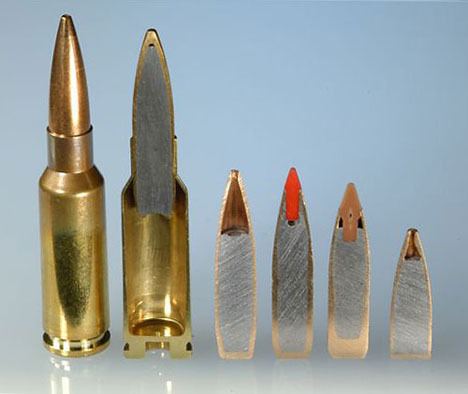Designed 2003 Case type Rimless, bottleneck | Place of origin United States Parent case .220 Russian | |
 | ||
Designer Bill Alexander and Janne Pohjoispää | ||
The 6.5mm Grendel (6.5×39mm) is an intermediate cartridge designed by Arne Brennan, Bill Alexander, and Janne Pohjoispää as a low recoil, high accuracy, 200-800 yard cartridge specifically for the AR-15. It is an improved variation of the 6.5mm PPC. Since its introduction, it has proven to be a versatile design and is now expanding out into other firearms including bolt-action rifles and the Kalashnikov system.
Contents
- Development and history
- Timeline
- Performance
- External ballistics
- Sporting uses
- Army and police uses
- References
The name "6.5mm Grendel" was a trademark owned by Alexander Arms until it was legally released to allow the cartridge to become SAAMI standardized.
Development and history
The 6.5mm Grendel design goal was to create an effective 200-800 yard AR-15 magazine-length cartridge for the AR-15 that surpassed the performance of the native 5.56 NATO / 223 Remington cartridge. Constrained by the length of the 5.56×45mm NATO round, the Grendel designers decided to use a shorter, larger diameter case for higher powder volume while allowing space for long, streamlined, high ballistic coefficient (BC) bullets. Firing factory loaded ammunition loaded with bullets ranging from 90 to 129 grains (5.8–8.4 g), its muzzle velocity ranges from 2,500 ft/s (760 m/s) with 129- and 130-grain (8.4 g) bullets to 2,900 ft/s (880 m/s) with 90 gr (5.8 g) bullets (similar in velocity to a 5.56 mm 77-grain (5.0 g) round).
The case head diameter of the Grendel is the same as that of the .220 Russian, the 7.62×39mm, and 6.5mm PPC cases. This diameter is larger than the 5.56×45mm NATO, thereby necessitating the use of a non-standard AR-15 bolt. The increased case diameter results in a small reduction in the capacity of standard size M16/AR-15 magazines. A Grendel magazine with the same dimensions as a STANAG 30-round 5.56 magazine will hold 26 rounds of 6.5mm ammunition.
Timeline
Performance
Proponents assert that the Grendel is a middle ground between the 5.56×45mm NATO and the 7.62×51mm NATO. It retains greater terminal energy at extended ranges than either of these cartridges due to its higher ballistic coefficient. For example, the 123 gr (8.0 g) 6.5 Grendel has more energy and better armor penetration at 1,000 meters than the larger and heavier 147 gr (9.5 g) M80 7.62 NATO round.
While the round has impressive performance, it is not without shortfalls. In order to obtain ballistics that are superior to the 7.62×51mm cartridge, a weapon with a longer barrel and firing a heavier bullet is necessary. To achieve the same results from shorter length barrels, even heavier bullets are needed.
External ballistics
As noted above, the Grendel case is very closely related to the .220 Russian case. In general, each additional grain of bullet weight will reduce muzzle velocity by 10 ft/s (47 m/s for each gram) and each additional inch of barrel length will increase muzzle velocity by 20 ft/s (2.4 m/s for each centimeter). Therefore, a handy rule of thumb is "one inch of barrel length equals two grains of bullet weight (1 mm → 5 mg)". Specific details are available as graphs derived from Alexander Arms' public domain load table linked below.
Sporting uses
The cartridge developer, Bill Alexander, has been quoted as saying he was looking for a cartridge with "more legs" (i.e. longer effective range) than the .50 Beowulf so that it could be used for white tail deer hunting. The round's original marketing for military and police usage created skepticism about its suitability for hunting. Despite this, there has been critical acknowledgement that it is sufficient for CXP2 class game such as deer. Its manufacturer is more enthusiastic, saying that it has "flat trajectories and bullets well-suited to deer and varmints". It is similar to deer cartridges such as the .30-30 Winchester, .257 Roberts and .243 Winchester but is not in the same class as the .270 Winchester or the 30-06.
Army and police uses
Serbia is in process of adopting rifle made by Zastava Arms in 6.5 mm Grendel caliber as main armament for its armed forces. USA manufactured rifle in 6.5mm Grendel caliber will also be adopted in armament for special forces units after it passes testing in Technical Testing Center. Three types of 6.5mm Grendel ammunition produced by Prvi Partizan Uzice Serbia will be tested for use with these rifles.
